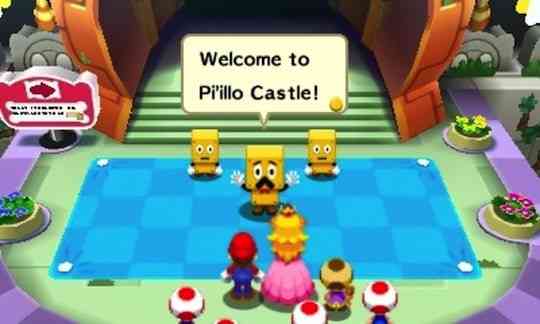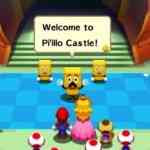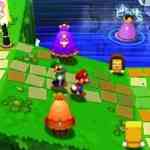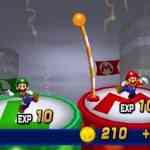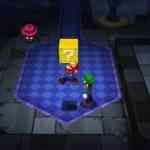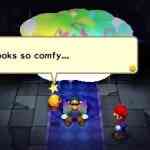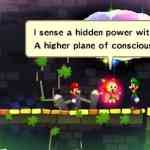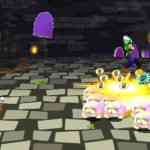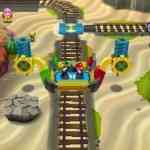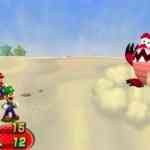Mario & Luigi have a fairly good track record when it comes to starring in RPG-like games, and their latest adventure, Mario & Luigi: Dream Team, once again shows that a mix of RPG and platform elements makes for an enjoyable game. I’ve dabbled in the last couple of games in the series, but I really dug into this latest one to see how things unfolded. Don’t ask me why Dream Team grabbed me more this time around, but alas it did. So, what is offered in this latest RPG/platform game with those two crazy plumbers? You’ll just have to read on to find out.
Our adventure starts out at Peach’s castle, where a crazy flying machine comes with a special invite to go off to somewhere new. Peach, Mario, Luigi, and a few other members of the Mushroom Kingdom board this blimp-like device and head off to what is supposed to be a new tourist destination, Pi’illo Island. But as would be expected in any Mario and/or Luigi based game, events occur that make things not what they seem, and of course that is the case here. You’ll learn that ancient Pi’illo people are trapped in the dream world by a new foe named of Antasma. You’ll rescue the trapped Pi’illo people and learn more about what happened. Of course what would a game with Mario & Luigi be if Bowser didn’t make an appearance too? Well, don’t worry as Dream Team has you covered here as that dastardly foe returns once again.
A large portion of the beginning of the game is basically one big tutorial. Luckily, if you’re a fan of the franchise and played previous games it will ask if you want to skip learning basic combat moves when the time comes. I was quite surprised with how much I forgot though, but I should not have been too shocked given it’s been awhile. Regardless, as you begin your adventure you’re eased into the controls all the while chipping away at the lengthy story.
Given the RPG nature of this game, there is A LOT of reading. Yep, for those looking to enjoy what the world of Pi’illo offers, and the story attached to it, you’ll have to do a lot of reading, so the young one’s better make sure to brush up on their reading skills. The story is quite enjoyable and I found that I talked to as many people as I could, not only to learn more about Pi’illo Island and it’s surrounding areas, but to enjoy the humour that was included in the dialog. Sure, it’s not gut-busting funny, but there were more then a few times I gave a little chuckle or a smirk came across my face. I can’t help but recommend that you speak with most every one you come across, as you never know what is going to be said or what you may receive. The world if Pi’illo is large too, so make sure to take the time to explore everywhere you can, as there is lots to see, lots to do, and lots to enjoy.
Those who have played past Mario & Luigi games know the combat system, so you can move on past this paragraph. For those new to this franchise you’ll find this a bit enlightening. Dream Team is not a traditional platform game; so don’t expect to be jumping on an enemy and then running on to the next. The combat involves some traditional RPG elements mixed with a bit of platforming. Your battles are turn based and can range from stomping, hammering, to using special timed attacks. Things are spiced up a lot, as there are real-time button pressing too. Press your button at just the right time as Mario or Luigi stomps or swings their hammer at the enemy and you’ll get a bit of bonus damage. Some of the special attacks also include timed moves between both characters; these are called Bros. Attacks (e.g. kicking a shell between both characters or charging up and firing fireballs). Defending also involves timed moves, like jumping or hammering at oncoming enemies or projectiles. The combat system as a whole keeps things a bit more exciting then just watching your character do their thing as you get to interact with the on-screen action.
One of the new and unique features of Dream Team is that you enter the realm of dreams. Here Luigi seems to have a very keen ability to fall asleep immediately when called for allowing Mario to enter the dream world. Where as the world of Pi’illo is traditional ¾ top down affair, the dream world sequences are a more 2D side-scrolling affair. You meet “Dreamy Luigi”, who Mario teams up with to complete each stage. These levels are unique in such that Luigi provides many of the gameplay elements to make these special. “Luigination” is the name of the features here, as he can possess trees or gear systems as well as clouds in the sky or star systems in the background to assist Mario in solving puzzles. You’ll use the touchscreen to interact with Luigi’s sleeping face to control some of these special sequences (e.g. pulling on his moustache to stretch the branches of palm trees to launch Mario to higher ground). All these Dreamy Luigi special sequences are ingenious in their use.
Battling in the dream world is also different. Instead of having both Mario and Luigi you’ll find that Mario absorbs Luigi to add to his HP, as well as provide some very cool attacks. Stomp on an enemy and a slew of Luigi’s rain down from the sky attacking your foes for bonus damage. There are also special attacks called “Luiginary Attacks”. Some of these attacks use the 3DS’s gyroscope feature. Most memorable for me was a Katamari-like sequence of collecting as many Luigi’s as you can and launching this big Luigi-ball at your enemy. All of the dream world specific powers make rescuing the trapped Pi’illo people that much more inviting and adds to the gameplay as a whole. I enjoyed this aspect for sure.
It’s evident from above that I enjoyed most of what is offered here, but if there is one area that I did struggle with now and then it was with the dual button control. Mario’s actions are controlled with the “A” button while Luigi’s actions are controlled with the “B” button. Although in theory this sounds like fun, when you are jumping from platform to platform, or having to run from an on-coming object and need to jump over an obstacle with both at the same time it can be quite a challenge to say the least. I am sure there are those out there that may not have a problem with this, but I know there will be those that do struggle. I had my patience challenged now and then and it could be frustrating at times to try to get both characters jumping or hammering at the same time by hitting two different buttons, but as you play more you will grow accustomed to this control scheme.
There are other features in the game that I am not expanding on, but given my urge to not get any wordier I’ll only mention what they are. Things like big boss battles including some epic Pacific Rim like moments where you turn the 3DS on it’s side to do battle, the ranking system for each character and the associated bonuses that comes with it (e.g. quicker leveling, more POW or DEF, extra item slot, etc.), the ability to learn new “Luigination” moves and “Luiginary” attacks, the ability to wear specific gear for added bonuses, more powerful equipment, special items, and so much more. This game is deep but yet so accessible that I think many will be able to grasp everything it comes with.
Visually I have to say that I was pretty impressed with Dream Team. What was quite noticeable to me right off the hop was with how bright and vibrant Pi’illo Island was and how it burst off the screen so to speak. As noted, you play on the island in a ¾ top down view. The island is quite populated with different looking characters, and each area of the island is also distinctive looking too, so you’ll enjoy what you’ll come across. Once you enter the dream world though the 2D world takes over and it is just as good as that of Pi’illo Island. With innovative design and eye-popping use of colours, you’ll be just as amazed with these levels. I found one particular level, where you eventually battle Bowser for the first time, pretty darn trippy. Characters animate fairly well too and I found little to no technical glitches during gameplay. 3D effects are pretty impressive with a good use of depth and special 3D specific tricks, such as a piece of a fountain coming up and breaking through the top screen.
In regards to the audio, as I played it became fairly evident that the sound track is a winner here. During all the sequences (e.g. explore, battle, menu, etc.) the music was perfect and I found that it had an uncanny nature of adding to the gameplay experience. It was not overbearing as it blended in just right. Coming out of the 3DS’s speakers it sounded pretty darn good, and through a good pair of headphones, well HELLO, it was awesome. As for the rest of the sound effects it is typical ‘Marioesque’ fare. One area I was disappointed with was the lack of voice work. I know this is a 3DS game, but there could have been more voices except for the odd “Mario”, “Luigi”, or “Help Me”, along with some unintelligible babble that occurred when Mario or Luigi were supposed to be talking with other characters.
Mario & Luigi: Dream Team is a game that I curiously found myself having a hard time putting down. I actually drained my 3DS battery more than a few times as I got so carried away playing. Sure, there are some quirks to the game now and then (e.g. two button control), but I can’t help but think how much fun people will have playing it. And as 2013 is the Year of Luigi it is nice to see how much of a big role he plays this time around. Go ahead, feel confident that you can pick up Dream Team and have a good time with it!
